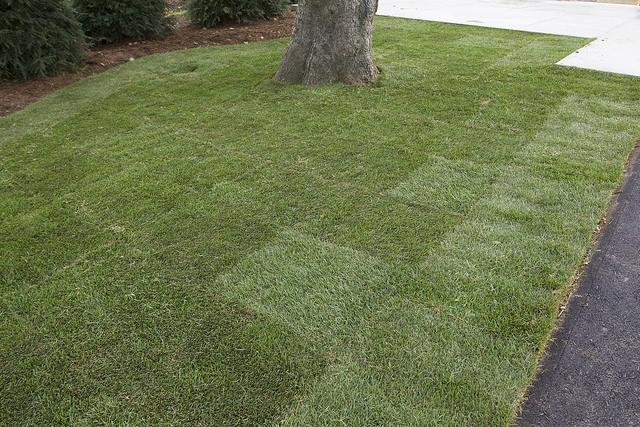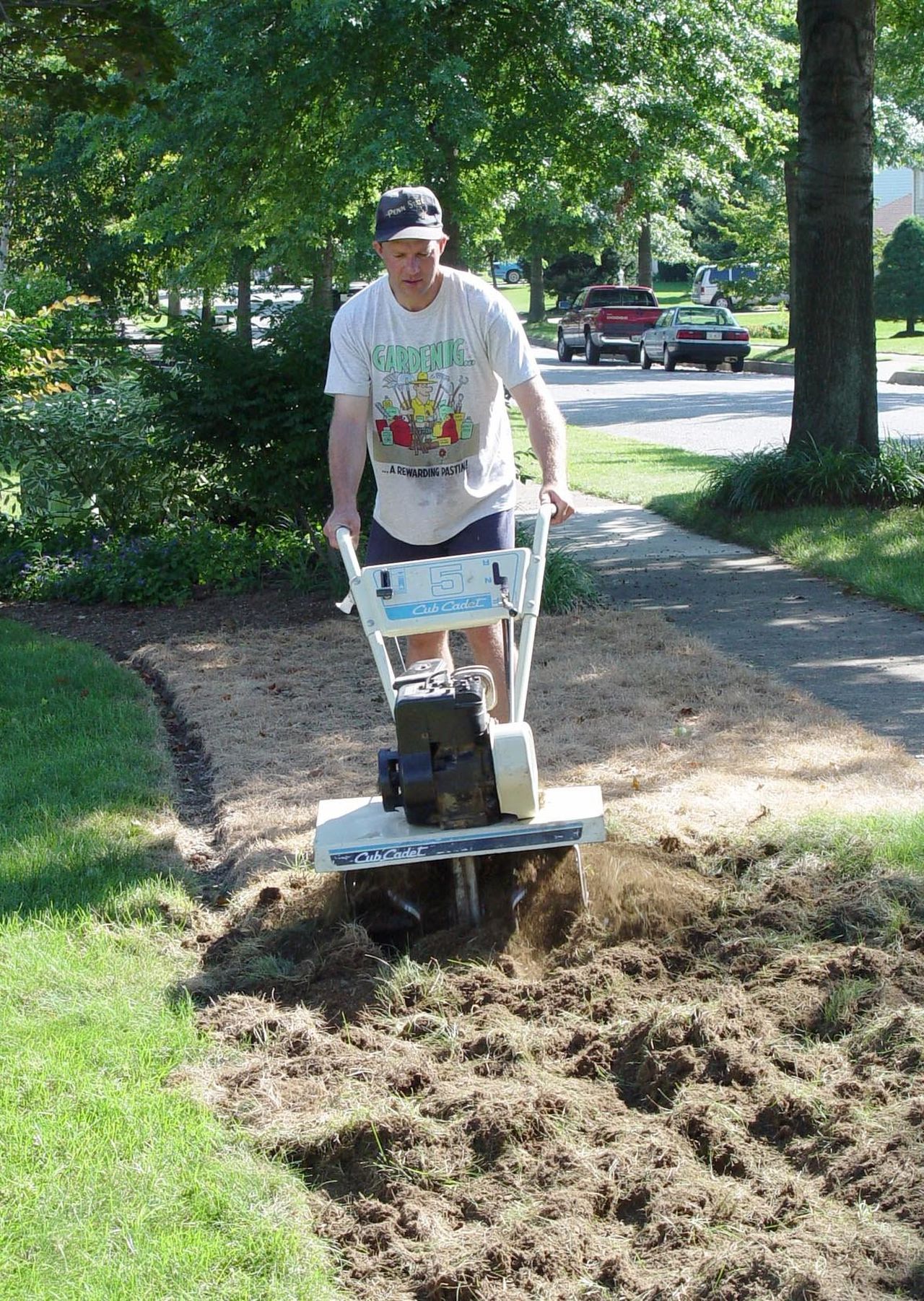To prepare an old lawn for new sod, first, remove all the existing vegetation by either manually pulling it out or using a sod cutter. Then, work the soil by tilling it to a depth of 4-6 inches, removing any rocks, roots, or debris.
Finally, level the soil and amend it with compost or organic matter to improve fertility and drainage.

Credit: greenhorizonssod.com
Why Prepare Your Old Lawn For New Sod
Preparing your old lawn for new sod is essential for a successful and healthy transformation. It allows for proper root establishment, prevents weed growth, and enhances water absorption. By taking the time to prepare your old lawn, you ensure that the new sod has a solid foundation to thrive.
Not only does this save you time and money in the long run, but it also results in a beautiful and vibrant lawn. Removing old grass, aerating the soil, and adding nutrient-rich amendments are just a few steps you can take.
So, whether you want to improve your home’s curb appeal or create a functional outdoor space, preparing your old lawn for new sod is a crucial step in the process.
How to Prepare Old Lawn for New Sod: Step by Step Guide
Assessing The Condition Of Your Old Lawn
Assessing the condition of your old lawn is crucial before laying new sod. Check for compacted soil, poor drainage, and the presence of weeds, pests, and diseases. Compacted soil and poor drainage hinder healthy growth, while weeds, pests, and diseases damage the overall appearance of the lawn.
By identifying these common issues, you can address them appropriately. If the soil is compacted, consider aerating it to improve air and water circulation. For poor drainage, ensure proper grading and consider installing a drainage system if necessary. Deal with weeds using herbicides or manual removal.
As for pests and diseases, consult a professional for the best course of action. Remember, the better you assess your old lawn, the better your new sod will thrive.
Clearing And Removing Debris From The Old Lawn
Clear the old lawn of debris by removing rocks, sticks, and other unwanted items. Cut back overgrown plants and shrubs to create a clean and even surface. Make sure to collect and dispose of the lawn clippings properly. By following these steps, you can prepare your old lawn for new sod effectively.
Remember to create a debris-free and well-maintained foundation for a successful sod installation. Prepare your lawn with care and attention to ensure the best results for your new turf.
Killing Weeds And Eliminating Pests
Preparing an old lawn for new sod involves killing weeds and eliminating pests. Using appropriate herbicides is essential to target and eradicate weeds effectively. Additionally, it is crucial to employ effective methods to eradicate pests and insects. By exploring organic alternatives for weed and pest control, you can maintain a healthy lawn without harmful chemicals.
With the right approach, you can ensure that your new sod takes root in a nourished and pest-free environment. Invest time in proper preparation to optimize the results when it comes to rejuvenating your lawn. Avoiding commonly overused phrases will keep your writing unique, engaging, and easy to understand.
By brushing up on these techniques, you can create seo-friendly content that will captivate readers, improve search rankings, and boost your website’s visibility.
Aerating The Old Lawn
Aerating your old lawn can bring numerous benefits, making it a crucial step in preparing for new sod. By using different methods of aerating the soil, you can improve its overall health and vitality. Timing and frequency also play a vital role, as aerating during the right season ensures optimal results.
Additionally, aerating helps with water and nutrient absorption, reduces soil compaction, and encourages root growth. It allows air to reach the roots, promoting a healthier and greener lawn. Not only does aeration improve soil structure, but it also enhances the effectiveness of fertilizers, minimizing waste.

By understanding the benefits of lawn aeration, you can ensure that your old lawn is in the best condition to support new sod. So, get started and enjoy a flourishing and beautiful lawn.
Testing And Amending The Soil
Preparing an old lawn for new sod requires testing the soil and making necessary amendments. Assess the ph levels and nutrient deficiencies to ensure optimal growth. Adding organic matter and amendments can improve the soil’s quality and provide the necessary nutrients for the new sod.
These steps are vital for creating a healthy foundation for your lawn, as they help promote proper root growth and nutrient absorption. By addressing any soil issues beforehand, you can ensure that your new sod will thrive and establish well.
Remember, a well-prepared soil is key to a beautiful and long-lasting lawn. So, take the time to test and amend your soil before laying the new sod, and enjoy a lush, vibrant turf in no time.
Leveling And Raking The Surface
Leveling and raking the surface of your old lawn is crucial when preparing for new sod. Properly leveling the ground will ensure a smooth and even base for the sod to be laid on. To achieve this, you will need the right tools and techniques.
Start by removing any low spots in the lawn and filling in any high areas to create a level ground. Next, use a rake to evenly distribute the soil and smooth out any bumps or uneven patches. Take your time and be thorough in this process to achieve the best results.
By meticulously leveling and raking the surface, you will provide a solid foundation for the new sod to thrive and establish a healthy lawn.
Irrigating And Watering The Old Lawn
To prepare your old lawn for new sod, proper irrigation and watering are essential. Deep watering promotes better root development, ensuring the success of your new sod. Understanding the right amount of water to provide for your old lawn is crucial.
Remember to follow these guidelines diligently: assess the commonly overused words and phrases that can hinder your writing. Keep your sentences concise, within a 20-word limit, to maintain seo friendliness. Use a variety of introductory phrases to captivate readers and avoid monotony.
Lastly, avoid including a conclusion paragraph. By adhering to these principles, you’ll optimize your old lawn’s condition for the successful installation of new sod.
Applying Pre-Sod Fertilizer
Preparing an old lawn for new sod is crucial for a successful turf installation. When applying pre-sod fertilizer, selecting the right type is essential. Proper techniques, such as even distribution and avoiding over-fertilization, are key for optimal results. Nurturing the soil before laying the new sod promotes healthy growth and establishment.
Adequate watering, maintaining moisture levels, and keeping foot traffic to a minimum are all important factors in caring for the soil. By following these guidelines, you can ensure that your old lawn is properly prepared for new sod, providing a lush and vibrant green space for years to come.
Laying The New Sod
To properly prepare your old lawn for new sod, follow these steps carefully. First, make sure to purchase quality sod to ensure successful establishment. Next, clear the old lawn of any debris and weeds. Prepare the soil by loosening it with a rake and adding compost or topsoil if necessary.

Once the soil is ready, lay the new sod in a staggered pattern, ensuring tight seams between each piece. After laying the sod, water it thoroughly to encourage root growth. Keep the sod evenly moist during the first few weeks, watering it daily or as needed.
As the new sod begins to take root, gradually reduce the frequency of watering. By following these guidelines diligently, you can enjoy a beautiful and healthy new lawn.
Maintaining The New Sod
Preparing an old lawn for new sod requires essential maintenance practices. Mowing, watering, and fertilizing should follow specific guidelines. Avoid common issues that may arise after sodding. Start by removing any existing weeds or grass from the old lawn. Level the soil and ensure it is well-drained.
Before laying the new sod, water the soil thoroughly. Once the sod is installed, mow it carefully, maintaining a height of around 2 inches. Water the sod regularly to keep it hydrated but avoid overwatering. Fertilize the sod as recommended, providing essential nutrients for its growth.
Address any common issues like wilting or discoloration promptly. By following these guidelines, you can maintain the new sod and enjoy a healthy, vibrant lawn
Frequently Asked Questions Of How To Prepare Old Lawn For New Sod
Can I Lay New Sod Over Old Grass?
Yes, you can lay new sod over old grass. However, it is important to prepare the old lawn properly by removing any debris, mowing the existing grass short, and loosening the topsoil. This will ensure good contact between the new sod and the old lawn, promoting healthy growth and root development.
What Is The Best Time To Install New Sod?
The best time to install new sod is during the cooler months of spring or fall. This allows the sod to establish its root system without the stress of extreme temperatures. Avoid installing new sod during the hot summer months as it can easily dry out and struggle to establish.
How Do You Prepare An Old Lawn For New Sod?
To prepare an old lawn for new sod, start by removing any existing debris, such as rocks, sticks, or dead vegetation. Next, mow the existing grass short and water the area thoroughly. Use a rake or lawn aerator to loosen the topsoil and remove any compacted areas.
Finally, apply a thin layer of topsoil or compost to improve soil quality before laying the new sod.
Should I Kill The Old Grass Before Laying New Sod?
It is not necessary to kill the old grass before laying new sod, but it can help in some cases. If the old grass is infested with weeds or diseases, applying a non-selective herbicide to kill the existing vegetation can prevent these issues from spreading to the new sod.
However, if the old grass is relatively healthy, proper preparation and soil conditioning will suffice.
How Long Does It Take For New Sod To Root?
New sod typically takes about 2 to 3 weeks to root properly. During this time, it is crucial to keep the sod consistently moist without overwatering. Avoid heavy foot traffic during the initial rooting stage to allow the roots to establish firmly.
Regular watering and proper care will ensure that the new sod becomes fully rooted and healthy.
Conclusion
Reviving an old lawn can feel like a daunting task, but with the right preparation, your new sod will thrive and transform your outdoor space. Begin by assessing the condition of your current lawn and removing any debris or weeds.
Next, loosen the soil and ensure proper drainage by aerating and leveling the area. Once these steps are complete, it’s time to lay your new sod, making sure to water it well and provide the necessary care to encourage root establishment.
Remember to regularly mow and fertilize your new lawn to maintain its health and vibrancy. By following these steps and putting in the effort, you’ll be rewarded with a lush and beautiful outdoor space. Get ready to enjoy your new sod and the many benefits it brings to your home.

